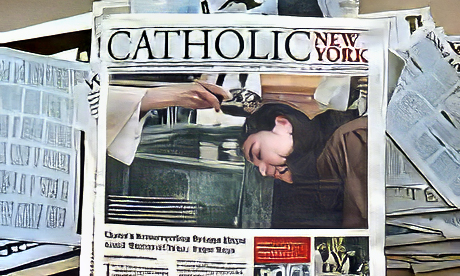Earlier this month, the Peoria Diocese in Illinois announced it had closed its diocesan newspaper, to be replaced with eventual “new strategies in a wider communications plan,” according to its bishop.
What “plays in Peoria,” however, is already part of a trend unlikely to slow: Bishops are cutting print publications or shuttering operations altogether, only to replace diocesan newspapers with soft-news magazines, websites and public relations content.
Meanwhile, new online, niche and sometimes ideological Catholic media are filling the gap.
The cuts to local Catholic media reflect wider journalistic trends of financially motivated decisions.
The week after Peoria’s announcement, the Los Angeles Times laid off more than 20% of its newsroom, and Sports Illustrated announced it was terminating “almost all” its staff — leading one commentator to call it “a week from hell in media.”
Catholic media — especially diocesan papers that provide local coverage and often serve as the vehicle for a bishop’s regular column — are not exempt from the larger forces affecting journalism, experts say.
In addition, they are negatively impacted by the decline in religious affiliation and participation in the U.S. and by competition from new Catholic media.
In fact, the Peoria paper wasn’t the only diocesan publication to cease operations at the end of 2023.
The Diocese of Green Bay, Wisconsin, whose first Catholic newspaper dates to the 19th century, published the last issue of The Compass at the end of December.
A year earlier, the country’s largest diocesan newspaper, Catholic New York, shut down, just as the U.S. bishops’ conference closed its national operations of Catholic News Service.
Other recent closures include Seattle’s paper in 2013, Akron’s in 2015 and Detroit’s in 2018.
In this country
we have so devalued
the idea of local journalism
that we’re in a big hole.
The number of Catholic newspapers in the U.S. dropped from 196 in 2006 to 118 in 2020, according to the Catholic Media Association.
The organisation’s current directory lists 84 newspapers as members.
“We need to take a step back and look at why this is not working,” said Helen Osman, president of SIGNIS, the World Catholic Association for Communication.
“This goes beyond just Catholic journalism. In this country we have so devalued the idea of local journalism that we’re in a big hole.”
Although she is frustrated by the loss of quality diocesan newspapers, Osman, who has worked in Catholic media and communication for nearly 40 years, says change is inevitable — and clearly already underway.
“I don’t think the practice and the art of journalism will change, but I think our understanding of how we do it in the church may change,” she said.
“We’re at a point in this country where we need to rethink the business model of journalism and its place in the community.
“When we do it best, whether Catholic or otherwise, local journalism builds up the common good.” Continue reading
